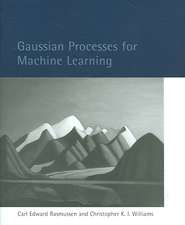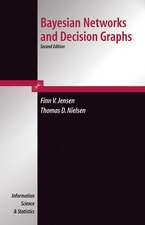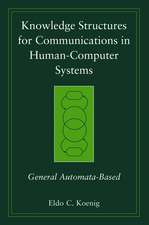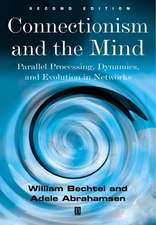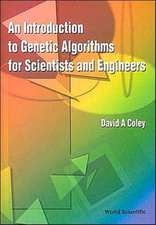Belief Functions: Theory and Applications: Proceedings of the 2nd International Conference on Belief Functions, Compiègne, France 9-11 May 2012: Advances in Intelligent and Soft Computing, cartea 164
Editat de Thierry Denoeux, Marie-Hélène Massonen Limba Engleză Paperback – 27 apr 2012
This volume contains the proceedings of the 2nd International Conference on Belief Functions that was held in Compiègne, France on 9-11 May 2012. It gathers 51 contributions describing recent developments both on theoretical issues (including approximation methods, combination rules, continuous belief functions, graphical models and independence concepts) and applications in various areas including classification, image processing, statistics and intelligent vehicles.
Din seria Advances in Intelligent and Soft Computing
- 18%
 Preț: 2813.03 lei
Preț: 2813.03 lei - 20%
 Preț: 1273.74 lei
Preț: 1273.74 lei - 18%
 Preț: 1214.72 lei
Preț: 1214.72 lei - 18%
 Preț: 1221.07 lei
Preț: 1221.07 lei - 20%
 Preț: 653.06 lei
Preț: 653.06 lei - 20%
 Preț: 1919.02 lei
Preț: 1919.02 lei - 20%
 Preț: 984.04 lei
Preț: 984.04 lei - 20%
 Preț: 1746.09 lei
Preț: 1746.09 lei - 20%
 Preț: 1906.99 lei
Preț: 1906.99 lei - 20%
 Preț: 1763.75 lei
Preț: 1763.75 lei - 20%
 Preț: 1278.68 lei
Preț: 1278.68 lei - 20%
 Preț: 1926.61 lei
Preț: 1926.61 lei - 20%
 Preț: 3183.20 lei
Preț: 3183.20 lei - 20%
 Preț: 334.86 lei
Preț: 334.86 lei - 20%
 Preț: 1916.55 lei
Preț: 1916.55 lei - 20%
 Preț: 981.25 lei
Preț: 981.25 lei - 20%
 Preț: 1934.70 lei
Preț: 1934.70 lei - 20%
 Preț: 1932.07 lei
Preț: 1932.07 lei - 20%
 Preț: 979.71 lei
Preț: 979.71 lei - 20%
 Preț: 1920.84 lei
Preț: 1920.84 lei - 15%
 Preț: 647.92 lei
Preț: 647.92 lei - 20%
 Preț: 985.86 lei
Preț: 985.86 lei - 20%
 Preț: 641.16 lei
Preț: 641.16 lei - 20%
 Preț: 3174.14 lei
Preț: 3174.14 lei - 20%
 Preț: 1293.71 lei
Preț: 1293.71 lei - 20%
 Preț: 2890.01 lei
Preț: 2890.01 lei - 20%
 Preț: 1924.15 lei
Preț: 1924.15 lei - 20%
 Preț: 1901.71 lei
Preț: 1901.71 lei - 20%
 Preț: 1934.70 lei
Preț: 1934.70 lei - 20%
 Preț: 1918.04 lei
Preț: 1918.04 lei - 20%
 Preț: 1919.02 lei
Preț: 1919.02 lei - 20%
 Preț: 419.25 lei
Preț: 419.25 lei - 20%
 Preț: 1310.68 lei
Preț: 1310.68 lei - 20%
 Preț: 1931.42 lei
Preț: 1931.42 lei - 20%
 Preț: 1941.96 lei
Preț: 1941.96 lei - 20%
 Preț: 2217.66 lei
Preț: 2217.66 lei - 20%
 Preț: 1297.17 lei
Preț: 1297.17 lei - 20%
 Preț: 1295.71 lei
Preț: 1295.71 lei - 20%
 Preț: 1306.07 lei
Preț: 1306.07 lei - 20%
 Preț: 1277.06 lei
Preț: 1277.06 lei - 20%
 Preț: 1909.64 lei
Preț: 1909.64 lei - 20%
 Preț: 668.07 lei
Preț: 668.07 lei
Preț: 1279.53 lei
Preț vechi: 1599.41 lei
-20% Nou
Puncte Express: 1919
Preț estimativ în valută:
244.87€ • 265.89$ • 205.69£
244.87€ • 265.89$ • 205.69£
Carte tipărită la comandă
Livrare economică 22 aprilie-06 mai
Preluare comenzi: 021 569.72.76
Specificații
ISBN-13: 9783642294600
ISBN-10: 364229460X
Pagini: 420
Ilustrații: XII, 444 p. 96 illus., 54 illus. in color.
Dimensiuni: 155 x 235 x 25 mm
Greutate: 0.64 kg
Ediția:2012
Editura: Springer Berlin, Heidelberg
Colecția Springer
Seria Advances in Intelligent and Soft Computing
Locul publicării:Berlin, Heidelberg, Germany
ISBN-10: 364229460X
Pagini: 420
Ilustrații: XII, 444 p. 96 illus., 54 illus. in color.
Dimensiuni: 155 x 235 x 25 mm
Greutate: 0.64 kg
Ediția:2012
Editura: Springer Berlin, Heidelberg
Colecția Springer
Seria Advances in Intelligent and Soft Computing
Locul publicării:Berlin, Heidelberg, Germany
Public țintă
ResearchCuprins
From the content: On belief functions and random sets.- Evidential Multi-label classification method using the Random k-Label sets approach.- An Evidential Improvement for Gender Profiling.- An Interval-Valued Dissimilarity Measure for Belief Functions Based on Credal Semantics.- An evidential pattern matching approach for vehicle identification.- Comparison between a Bayesian approach and a method based on continuous belief functions for pattern recognition.- Prognostic by classification of predictions combining similarity-based estimation and belief functions.- Adaptative initialisation of a EvKNN classification algorithm.
Textul de pe ultima copertă
The theory of belief functions, also known as evidence theory or Dempster-Shafer theory, was first introduced by Arthur P. Dempster in the context of statistical inference, and was later developed by Glenn Shafer as a general framework for modeling epistemic uncertainty. These early contributions have been the starting points of many important developments, including the Transferable Belief Model and the Theory of Hints. The theory of belief functions is now well established as a general framework for reasoning with uncertainty, and has well understood connections to other frameworks such as probability, possibility and imprecise probability theories.
This volume contains the proceedings of the 2nd International Conference on Belief Functions that was held in Compiègne, France on 9-11 May 2012. It gathers 51 contributions describing recent developments both on theoretical issues (including approximation methods, combination rules, continuous belief functions, graphical models and independence concepts) and applications in various areas including classification, image processing, statistics and intelligent vehicles.
This volume contains the proceedings of the 2nd International Conference on Belief Functions that was held in Compiègne, France on 9-11 May 2012. It gathers 51 contributions describing recent developments both on theoretical issues (including approximation methods, combination rules, continuous belief functions, graphical models and independence concepts) and applications in various areas including classification, image processing, statistics and intelligent vehicles.
Caracteristici
Latest research on theory and applications Belief functions Results of the 2nd International Conference on Belief Functions, Compiègne, France 9-11 May 2012 Written by leading experts in the field



